The following checklist of plants in the past and present King’s Copse Park Botanical Gardens (KCP BG) Aroid collection serves as my personal reference to help keep track of all these, but is open to consultation by others with an interest. The quoted status of most species is to spring 2024. Links to suppliers of each plant are included.
Amorphophalli
This is a genus of more than 230 tuberous Aroids, most of which are native to the tropical and sub-tropical zone of Asia. Several species occur in Africa, and a few more in Australia and some Polynesian islands. Four appear to be generally available for purchase by European collectors, of which I have experimented with three.
Amorphophallus bulbifer
Status: For the 2020 season I purchased a large Taylors Bulbs tuber from a local garden centre, something I had not recalled seeing in previous years, and two more from Himalayan Gardens of Forfar, all of which were planted in plastic pots. The first rotted while of the latter two one produced foliage only and the second bloomed in mid-September. It took several days for the spathe to open fully and reveal the flowers at the base of the spadix (centre, below), by when the edges had begun to wilt.



A bulbifer is native to north-east India and the Himalayan region. The bloom is said to reach around 40cm (16 inches) in length, and is followed by foliage up to a metre in height. One of my suppliers Adventurous Plants advises against buying Aroid tubers imported from Indian wholesalers (see here) and that other sources of Amorphophallus have been of “mixed and unpredictable quality”.
But at £3 – 4 each the 2020 acquisitions seemed worth giving a try. Through that season and since my experience of garden centre-sourced Amo, Arisaema and Sauromatum tubers supported AP’s advice. So I accept the inevitable outcome cited by AP which further advises leaf bulbils are a more reliable way of growing these plants. I think success with this latter option must take a lot of time and expertise though.
Amo nepalensis
Status: A scarcer Amo species in cultivation, I sourced one from Himalayan Gardens in February 2020 and another from the Burford Garden Centre in Oxfordshire (that was actually described as A bulbifer). The latter broke the surface in its pot on 9th July, revealing it’s true colours 12 days later on 21st; and this spathe also took several days to open fully. The tuber that was damaged on purchase then rotted in its pot. The former produced foliage only and was re-potted for 2021 but didn’t bloom again before also rotting.



The KCP BG Aroid of the year for 2020 (pictured above) is endemic to the eastern Himalayan region where it occurs at high altitude in India, Nepal, Bhutan and Bangladesh. The mildly foul smelling inflorescence has a large, sail-like spathe up to 50 cm long, pale creamy yellow on the inside and more greenish on the outside. The stout but long spadix is brownish-mauve at the base and creamy yellow on the top half. Large umbrella like compound leaves with mottled leopard-spotted stalks follow on after the bloom has emerged, also reaching up to 1 metre tall.
Amo konjac
Status: I acquired a growing plant from Tropical Britain in August 2020 that was not expected to flower in that year. Two days after seeing what is a collector’s item was available the released stock had sold out, so I was very pleased to have one. The nursery grown tuber produced foliage only again each season from 2021 to 2023, and has been lifted along with multiple offsets to store dry through each winter, the only one of my Amo tubers to survive this long.

This tall Aroid, also known as “Devil’s Tongue”, is native to the south-east Asian and Far East region. It is said to be one of the easier Amos for a temperate climate and fully hardy. The dark-maroon inflorescence should rise in spring, having a similarly toned erect spadix and strong foetid odour. The foliage emerges in early summer and grows rapidly. The stalk is mottled with pale pink and grey or olive-green and brownish spots, and is divided at the top to form a classic Amo structure resembling a canopy from which the leaves hang. As the foliage withers new bulbils are produced on the ends of rhizomatous growths from the tuber. The rhizomes eventually wither away to free the bulbils which can then be lifted.
Arisaemae
This is a diverse genus of Aroids containing more than 250 species. The largest concentration occurs in China and Japan, with other species native to other parts of southern Asia as well as eastern and central Africa, Mexico and eastern North America. Asiatic species are frequently called Cobra Lilies, while western species often share the colloquial name “Jack in the Pulpit”. All are winter dormant.
For a cultivation guide see here. According to this they are best planted from mid to late autumn in a well drained alkaline or ericaceous growing medium, mixed with composted bark and leaf mould. There is no need to add grit or sand which can damage the tubers. Plants may start into growth in late winter and respond well to extra feeding early in their cycle. A long growing season combined with plenty of available nutrients will cause tubers to bulk up faster, resulting in more reliable flowering.
Arisaema ciliatum
Status: Sourced from Adventurous Plants (x2) in spring 2018, both bloomed in my wooden Aroid trough in their first season. One flowered again each July from 2019 to 2021, but not in 2022 then no growth at all appeared in 2023.

This is said to be one of the easiest Arisaemae to grow. Native to China where it occurs up to 2500 metres, it is hardy and under ideal conditions is said to multiply readily. The brown and green striped inflorescence is held high up within the foliage.

Arisaema consanguineum
Status: Sourced from Adventurous Plants in spring 2019, this produced foliage only in the trough in it’s first two seasons, then bloomed indoors on 28th September 2021. The flower proved to be long lasting for 11 days until 8th October after which it began to wilt. Replanted for 2022, the tuber failed to produce growth then rotted in the autumn.


A consanguineum has either one or two leaves, each with attractive variegation running down the centre, and often with tips ending in long drooping threads. The deeply coloured spathe is generally green with hints of red or maroon. This is the most widespread of all the Asian species and there are numerous regional differences amongst wild populations.
Arisaema costatum
Status: Sourced from Adventurous Plants in spring 2019, this was planted outside in an earthenware pot but took until its second season to shoot and bloom in June 2020. It was puny in 2021 and so discarded.
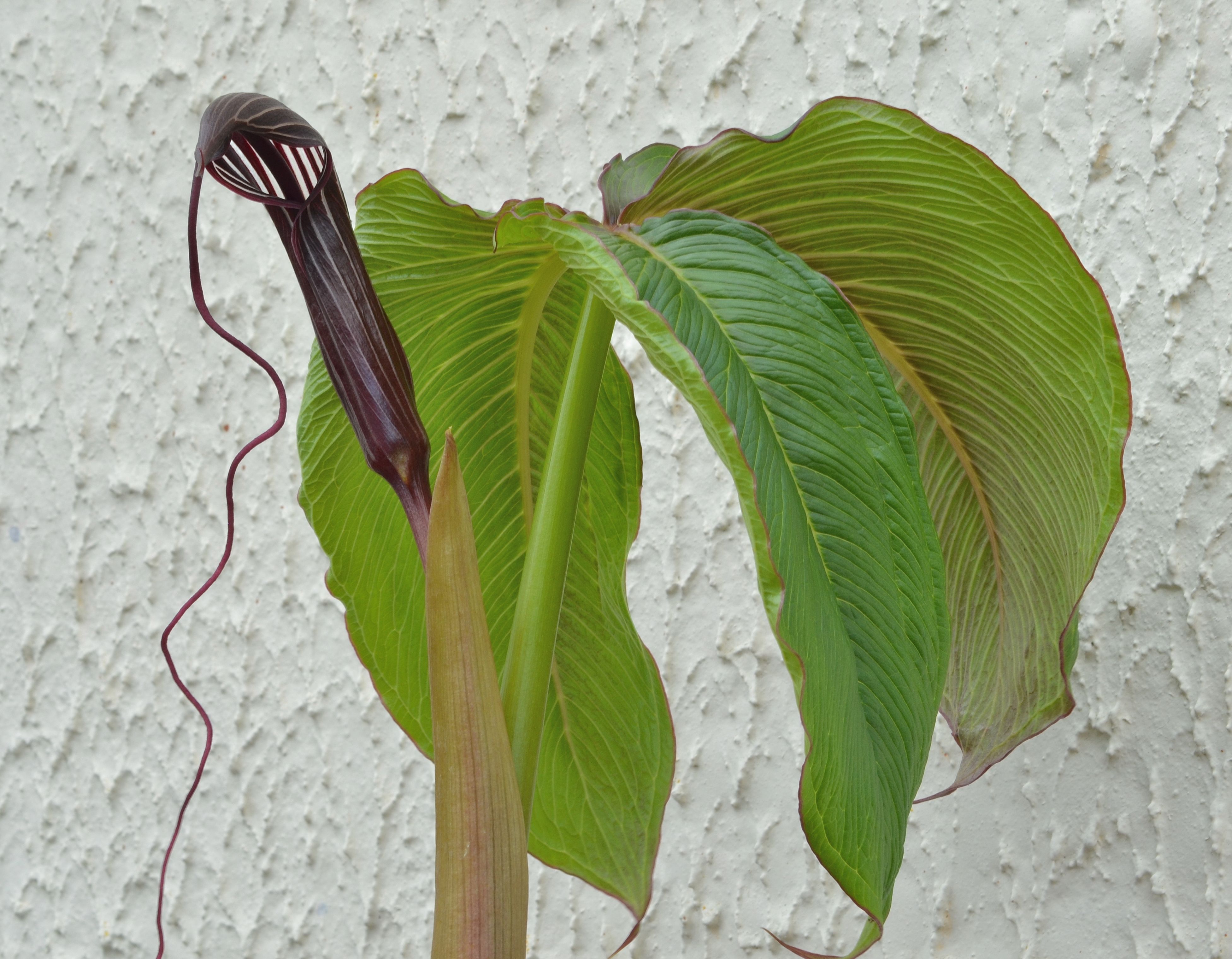

Appearing in late spring or early summer, the single tri-foliolate leaf is large and glossy with attractive veining. The brightly coloured spathe, held beneath the leaves has white stripes that contrast with the maroon background. The long spadix appendage trails away in a twisted fashion, often ending in a coiled bunch. This plant is native to the Himalayan region where it grows on cliffs, in woodland shade or forest clearings.
Arisaema ringens
Status: Sourced from Edulis of Ashampstead, Berks in spring 2018, this has flowered in the trough in each of its seven seasons so far. There were two blooms and more smaller stems in each of 2020 and 2021 (below, top right), four in 2022 (bottom right) and 2023, and five in 2024. So this has been the only Arisaema to offer any longevity here.

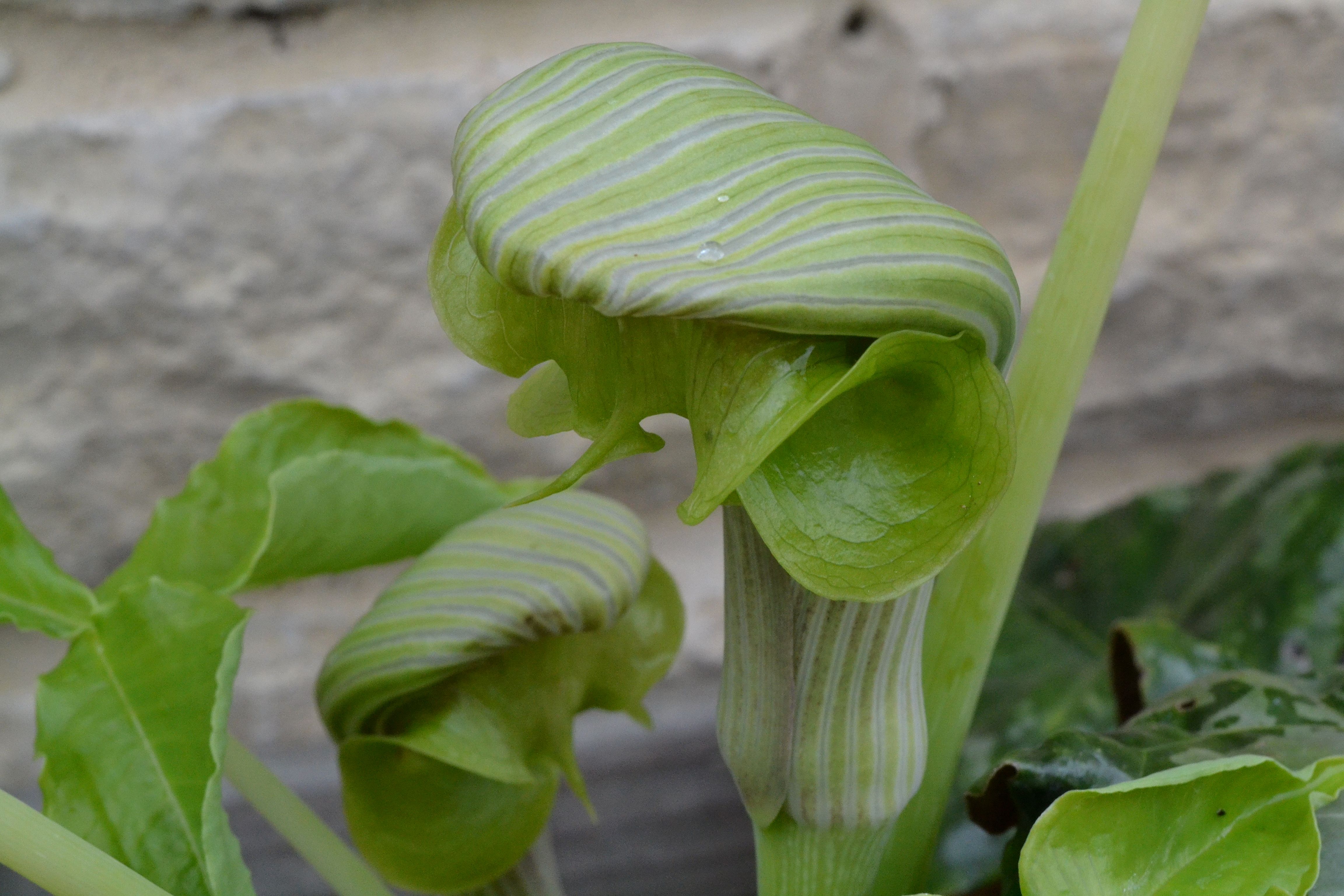

This Aroid (pictured above) is fully hardy and early flowering, emerging in March and April. Native to Japan, it is capable of making large tubers and clumps in time. The distinctive helmet-shaped spathe has a tightly re-curved hood that folds down over the mouth so it is difficult to see inside, and it lasts for some time before withering away. Each tuber produces two trifoliate, glossy green leaves.
Arisaema tortuosum
Status: Sourced from Shady Plants (x2) of Painswick, Glos in spring 2018, they grew very quickly and bloomed in the trough in their first season. After being planted out in semi-shade they broke the surface in May 2019 to bloom again, but then became prone to rotting which can be an issue. I have since acquired more imported tubers from different sources with rot remaining an issue.



Native to the Himalayan region, the “Whipcord Lily” (pictured above) is said to be cold tolerant in Britain if given the right conditions. This Aroid, the tallest of its genus usually breaks ground in late spring or early summer, producing a green, veined spathe and elongated spadix that curves vertically and can reach 2 metres in height in the event of surviving to maturity.
Arums
This is a genus of 26 accepted species occurring from western through central Europe and across central Asia, and also in North Africa. The blooms of different species vary in colour from pale green through yellow, rusty red, deep purple and black. Cultivation is said to be simple in well-drained loam in sun or light shade. Most produce foliage in the autumn and over-winter in the green state, being cold resistant and becoming deep seated in the ground, but they are not necessarily hardy in pots.
Arum apulum
Status: Sourced from RarePlants.co.uk as a cultivated tuber in October 2020, this Italian endemic bloomed on 22nd February 2021, wilting three days later, but not in 2022. Then after being transferred to the outside trough the tuber was lost to severe frosts during the following winter.
In the wild this shade loving plant occurs only across a limited area of south-eastern Italy’s central Apulia region, around the towns of Bari and Taranto. There habitat encroachment by commercial development has contributed to the plant acquiring critically endangered status.
Normally blooming in early summer, the large spathe can be deep purple-red inside, toning to paler violet at the very centre around a deep purple-red spadix (below, right). But other specimens such as my own (left) are pale lime-green with maroon overtones and a brownish-maroon spadix. So having selected this addition item for that attractive colouration this result (below left) actually resembled a rather firmer Cuckoo Pint. The compact and robust foliage (centre) is dark green and unspotted.



A apulum rarely reaches more than 30cm in height. The pollinator attracting odour is reputedly more manageable for indoor cultivation than others of the genus, and our specimen bore that out smelling only slightly for its first evening in bloom.
Arum concinnatum
Status: Sourced from Adventurous Plants (x3) in September 2019, I expected this to be similar to A italiacum in habit, being in leaf throughout the winter and blooming in late spring to early summer. After being planted in plastic pots to over-winter outside they did not bloom in spring 2020. When lifted in August two of the tubers had multiplied readily, allowing several plants to be re-potted in gritty, loam-based compost to grow through the winter in my cold frame. One of these bloomed on 12th April 2021 (pictured below, centre and right) but was the only one to do so. Most of the stock was planted out for 2022 but none flowered until one more item in 2024.



Native to the Aegean region of the Mediterranean and fully hardy in British conditions, this is one of the largest of the Arums capable of reaching almost a metre in height when fully established and mature. It is large leaved and bears an inflorescence with a greenish-yellow spathe and thick yellow spadix. The spathe that smells of animal excrement in the initial stages of flowering can be variable in colouration, sometimes with a purplish tinge and usually has a purple margin. This plant is summer dormant, the foliage appearing in autumn then is maintained through frost, forming a large clump. The blooms appear in mid-Spring.
Arum creticum
Status: Sourced from Adventurous Plants in autumn 2018, this has not bloomed in each of its first five seasons, either in a pot or in the ground. It (pictured below) is a large variety from Crete and Turkey that is unusual amongst Aroids in having a rather pleasant smell likened to rose, lemon or orangeade.


A creticum is summer dormant, starting into growth in autumn before blooming the following April and May. It has unmarked, glossy green leaves and produces spathes in various hues of white or pale yellow. Mature clumps are said to reach around a metre in height and spread.
Arum discoridis syriacum
Status: Sourced from Adventurous Plants in autumn 2019, I expected this like A concinnatum to be in leaf throughout the winter, blooming in late spring to early summer, followed by fruit spikes in the autumn. Planted in an 18cm plastic pot for growing outside, it did not flower in 2020. Then lifting the tubers in August, I cultivated multiple plants in the cold frame through the winter in sandy, loam-based compost but none of them bloomed in 2021. So these were planted out for 2022, eventually producing a single inflorescence on 24th May (pictured below, left and centre), then other singles on 3rd June 2023 (right) and May 2024..


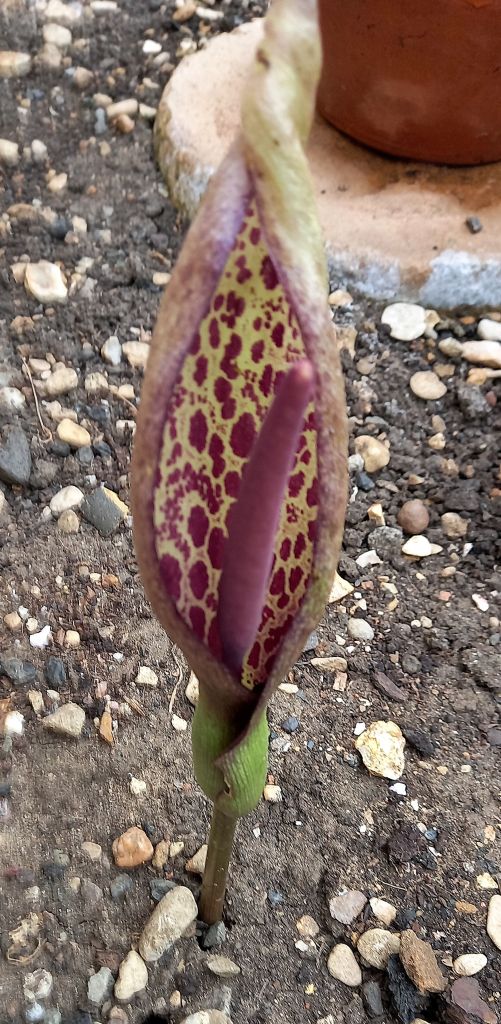
A discoridis is a variable and widespread genus, native to forests in the eastern Mediterranean and Middle East regions. This one is endemic to central southern Turkey and north-west Syria, having a distinct pattern of maroon blotches to the inside of the pale green spathe, and a maroon spadix. Also known as “Spotted Arum”, variation exists not just from plant to plant but from flower to flower on the same plant. It grows up to 60cm in height, with spathes to 38cm when mature, and is said to do particularly well if grown under glass. More varieties are available from British suppliers.
Arum euxinum
Status: Sourced from RarePlants.co.uk in October 2020, this bloomed on 11th March 2021 but not in 2022 before also being lost to severe winter frost. The scarcity originates from the Black Sea coast of northern Turkey, but the stock is from seed distributed by Gothenburg Botanic Gardens. In the wild this item occurs in mountainous regions and normally blooms in May.


Upon unfolding, the odourless, pinched bloom (above righf) appeared quite similar to the early-flowering middle eastern A hygrophylum. But euxinum is somewhat taller and much more robust. The plain, dark green foliage is very attractive and the entire plant a pleasing shape (above left). The 40 – 60cm tall spathe is compact, scentless and pinched into a waist. The colouration is described as very pale green stained purple at the edges, top and base, with an interior of pale cream or white marked with rich purple towards the tip.


Whether or not the colouration would evolve with age remained to be seen. Through day one the increasingly firm and waxy spathe did acquire more of the shape of the supplier’s picture (above centre). Then from day two more of the anticipated delicate purple toning seemed to intensify in tandem with the allurement A euxinum came to offer.
The left hand picture below is from day two and the other two day three. By then I could fully concur with the supplier’s description. Later on day three the inflorescence deformed (below right) becoming more purple all the while. This had become perhaps the most subtly intriguing aroid ever cultivated here. Wilting began on day 5.



Arum hygrophylum
Status: Sourced from Adventurous Plants in autumn 2018, this was initially kept indoors in its supplied pot, producing a single January bloom (below left). Having gained this experience it was planted at the front of the Aroid bed for 2019/20, where it produced blooms in February and April. In it’s third season this item bloomed again (centre) on 20th April 2021. In 2022 (right) the now mature clump produced a succession of eight blooms, then12 in 2023.



This plant, also known as “Water Arum”, is native to the Middle East from Syria to Jordan, and also Morocco. It is summer dormant with leaves up to 60 cm long appearing in autumn, followed by the narrow “waisted” inflorescence by early spring. The creamy green spathes are edged with maroon and the slender spadices are pale purple. I was a little disappointed with the 2019 bloom (above left) that did not seem markedly different from wild Cuckoo Pints, but in subsequent seasons the slender pinched form more closely matched published pictures.
Despite a reputation for being tender A hygrophylum is said to be hardy if given a sheltered position from the worst of wind and frost. It thrives left to its own devices planted out in moist soil and, as I found tends to struggle when grown in pots. It will often try to flower in January, as was also my experience. But cold will knock back the early flowers outside, and my plant suffered a real battering in the strong, cold winds of Jan and Feb 2020.
Arum italicum
These are pretty much the Mediterranean equivalent of our own Cuckoo Pints. Two varieties sourced from a small nursery near Wantage have over the last 18 years or so colonised, or perhaps invaded KCP BG quite successfully.



They have twin advantages that bold and shiny, arrow-shaped leaves appear in autumn and resist all attention from frost throughout the winter. Then after the foliage withers the subtle creamy blooms turn into equally striking spikes of brightly coloured fruits through the summer. So this is a truly eye-catching plant in all its stages (pictured above).
In most seasons the blooms tend to be rather submerged within the foliage of the many clumps in KCP BG. But in 2020 strong wind and rain through January and February followed by mostly quite exceptional fair weather from late March to early May caused the foliage to wilt earlier than usual. The many large inflorescences were thus much more visible, as these pictures (below) show.


Arum maculatum
These spring flowering wild Aroids are a common and widespread woodland plant across much of Europe and occur naturally around the margins of KCP BG. The glossy, spear-shaped leaves appear in mid-winter, followed by blooms in April (below) that last for little more than a day. Then the whole plant quickly wilts and later in the season the stems turn into spikes of orange berries. There are a host of colloquial names but the one I prefer is “Cuckoo Pint”.


Complete checklist of the genus Arum
In addition to these 26 accepted species, there are a number of synonyms and unresolved items that differ according to various authorities. But as far as I can ascertain, this (below) is the general picture. Asterisks denote species currently being cultivated at KCP BG.
- apulum *
Endemic to central Apulia in SE Italy and related to A nigrum from the Balkans. Blooms in April. - balansanum
Native to Turkey. - besserianum
Native to S Poland and the Ukraine. - concinnatum *
Native to the southern Peloponnese of Greece, most Aegean islands and SW coasts of Turkey. One of the largest Arums, capable of reaching a metre in height. Exhibits various leaf forms. Blooms (foul smelling) in mid-spring. Also known as: byzantinum or nickelii. - creticum *
Native to the mountains of Crete, Greece and a few places in SW Turkey.
Blooms (scented) in April / May. - cylindraceum
Widespread from southern Sweden to Crete and from Portugal to Turkey. Also known as alpinum and lucanum. - cyrenaicum *
Rarity from SW Crete and NE Libya. Blooms in late spring / early summer. - discoridis *
Occurs widely across eastern Mediterranean region, with different forms:
var cyprium
var philistaeum
var syriacum – central southern Turkey and NW Syria. - euxinum *
Rarity from mountains around the Black Sea coast of northern Turkey. Blooms (scentless) in May. - gratum
Native to NW Turkey, Syria and Lebanon. Blooms scented) May – June and rarely into July. - hainesii
Native to eastern Iraq. Blooms in May. - hygrophilum *
Occurs in NE Morocco, E Cyprus, SW Syria and W Jordan. Blooms (scentless) in late winter or early spring. - idaeum
Rare endemic to the highest Cretan mountains. - italicum *
Widespread in woodland and hedgerows throughout Europe, N Africa and Asia Minor. Exhibits various leaf forms:
ssp albispathum
ssp canariense - jacquemonti
Occurs from NE Iran through Central Asian region to W China. Blooms April – May. - korolkowii
Occurs in N Iran, Afghanistan and through central Asia to NW China. - lucanum
S Italian rarity occurring in high elevation habitats above 1000 metres. - maculatum *
Common and widespread in woodland and hedgerows across much of Europe. The English Cuckoo Pint (see here). - megobrebi
Recently described species from mountains between Turkey and Georgia. Blooms in late spring. - nigrum
Native to the Balkans, blooming in May – June. - orientale
Occurs from Austria and Poland through eastern central Europe to NE Turkey, the Crimea and W Caucasus. Blooms May – June. Also known as alpinariae and elongatum. - palaestinum
Occurs in Israel, W Syria, Lebanon and Jordan. - pictum
Occurs in rocky habitats of the Tyrhennian and Balearic islands, and is the only autumn flowering (foul smelling) member of the genus. - purpureospathum
Endemic to Crete. - rupicola (or conophalloides)
Occurs from eastern Aegean islands to Israel and Iran. Blooms from April to late June, and into July in cultivation. - sintenisii *
Native to northern Cyprus. Blooms (scented) in spring.
Other Aroids
Arisarum proboscideum
Status: Sourced at the Rare Plant Fair early in 2018, this made quite a clump in my Aroid trough, blooming profusely in it’s second and third seasons. The rhizomes were lifted to plant out in my shrub border in autumn 2020, eventually producing two splendid clumps for the 2023 season. Some of the bigger ones were replanted in the trough, blooming again in spring 2022 but not 2023. The wet spring of 2024 appeared to suit this plant well as it swelled to two even larger clumps containing numerous hidden mice.


The “Mouse Plant” (pictured above) is so called because the flowers are said to resemble those small furry mammals going to ground. Each suggests a mouse diving for cover through the leaves, with the tail following on behind. It is native to shady woodlands in the Mediterranean region east to the Caucasus, where it grows beneath Cork Oaks. The amusing cream and brown blooms of this spreading plant are partially concealed within dense mats of bright green, arrow shaped foliage. It is easy to cultivate and fully hardy.
Dracunculus vulgaris
Status: Sourced from Anglia Bulbs (x3 flowering sized tubers) in autumn 2018. Two of these have formed the focal point of my Aroid bed, while the third rotted. These bloomed in June 2019 then in each of 2020 and 2021. Only the large clump produced foliage in 2022 and I missed the blooming event in mid-June due to being in hospital. This annual spectacle was then wiped out by the severe winter frosts of 2022/23. Four offset tubers were either potted or re-planted in the ground, but did nothing in 2024.



It was seeing this plant, known as the “Dragon Arum” growing wild in Greece (above left) in May 2017 that prompted me to start collecting exotic Aroids. Native to the eastern Mediterranean, it is said to be relatively easy to cultivate in Britain being fully hardy, and that has indeed been my own experience. The tubers (above right) send up robust shoots in February and March that grow quickly forming stems to more than a metre tall.
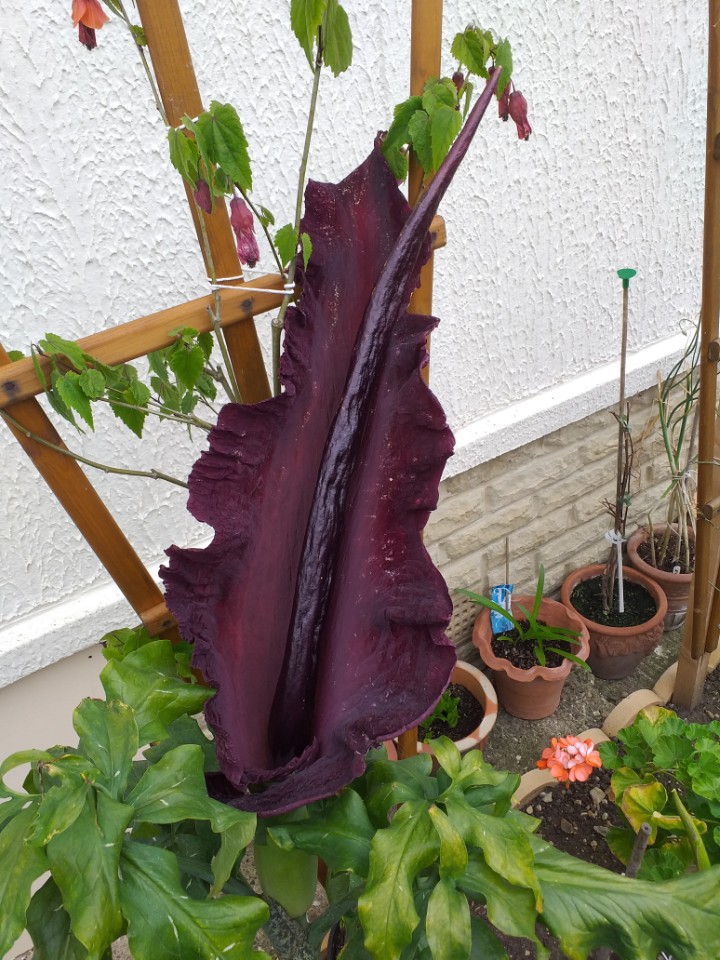

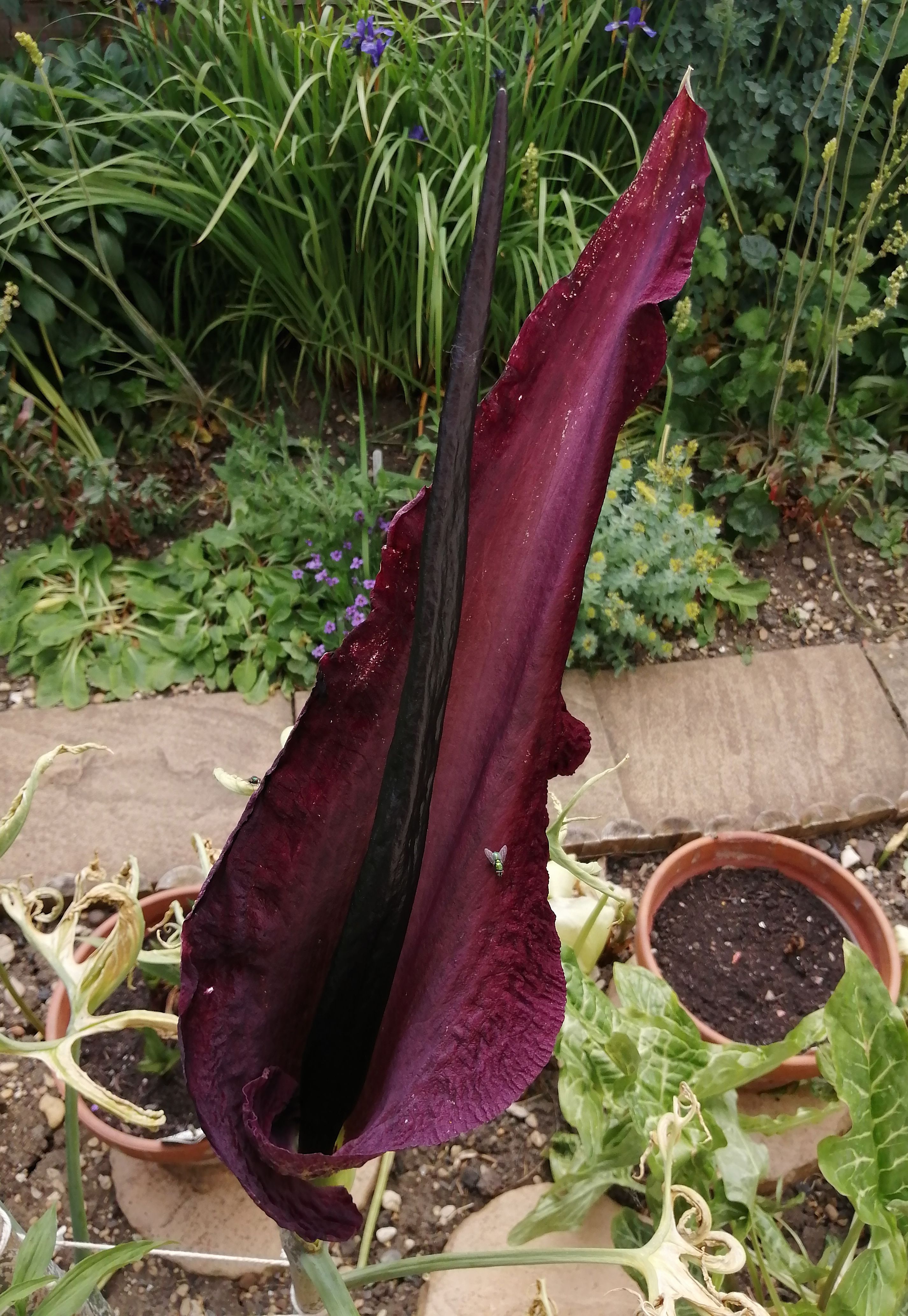

The deep magenta inflorescence begins to appear in mid-spring and grows up to 60 cm or more long. This is foul smelling to attract pollinators when it first blooms, but only for a couple of days. After flowering, these hungry plants should be kept well watered and fed then the reward is said to be an even better display the following year. That has been my own experience as in 2021 the best developed clump produced five stems (above left) and the second tuber produced an even more impressive bloom (right).


Helicodiceros muscivorus
Status: Sourced from Rareplants.co.uk in October 2020, this was potted for indoor cultivation through that coming winter and refreshed again 11 months later. The tuber was supplied as being two years away from flowering but disappointingly did not bloom in spring 2022 or 2023, and in 2024 did not even produce foliage. The tuber also became smaller each season instead of putting on bulk, and has now been put in the Aroid trough outside as a last resort.
This collector’s item (pictured above), also known as the “Dead Horse Arum” is the only plant of the Helicodiceros genus, originating from rocky coastal cliffs on a few Mediterranean islands: Corsica, Sardinia and the Balearics. The foliage is a pale matt-green and the quite remarkable inflorescence is described as exhibiting “shades of flesh-pink and jade-green blotched all over with purple and emerald”. The dark grey-toned spadix is covered in hairs.
Growth tends to start in early winter and blooming will eventually occur during the spring. A frost free location is preferable such as a cool greenhouse or conservatory. This is reputed to be amongst the 10 most foul smelling plants in the world through the two day flowering period.
Pinellia tripartita
Status: Sourced from Adventurous Plants (x2) in early summer 2018, these have performed reliably through each season since, producing repeated blooms. One clump remains in the trough, and the second having been moved to the Aroid bed has become established there (pictured below).
This is a winter dormant, easy to grow woodland Aroid from east Asia (China, Korea and Japan). Emerging during spring, it is vigorous and quick growing and soon produces a good-sized clump from self-dividing tubers. Fully hardy, it has delicate looking pale green spathes with long spadices. Cool shady situations are preferred.

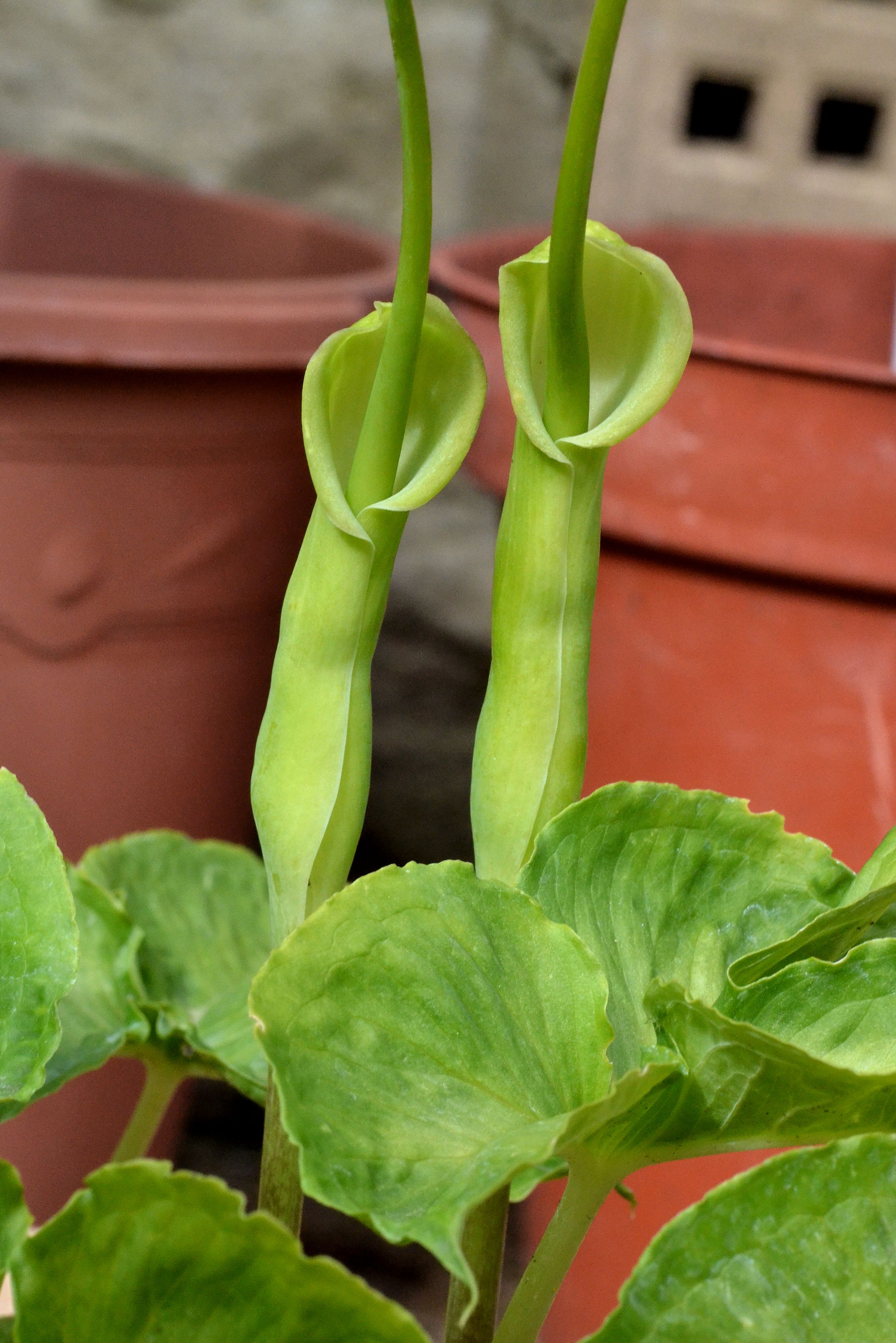
Sauromatum venosum
Status: Sourced from Adventurous Plants (x2) in spring 2018, these were grown outdoors in 2 litre plastic pots, not flowering but the tubers doubled in size. One overwintered under cover outside in its pot, and the second was stored dry indoors. The potted one bloomed just for one day on 3rd June 2019, since when both and a number of offsets have produced foliage only in subsequent seasons.
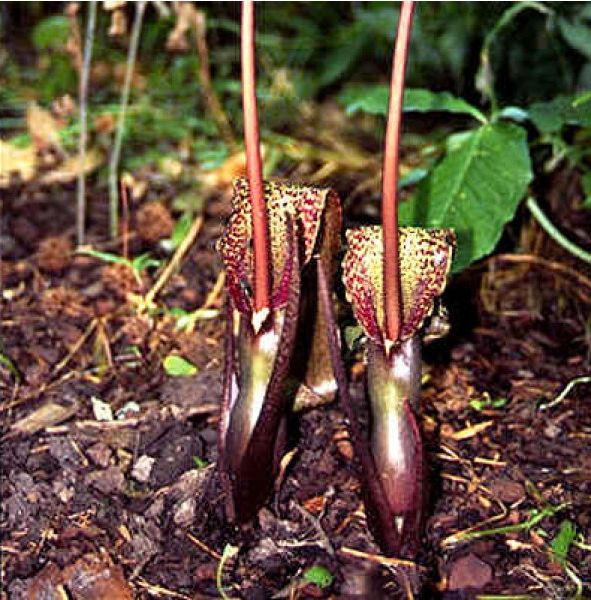


These are “Indian Giant”, the larger form of S venosum that originates from tropical Africa eastward to China. In time tubers (above right) can become huge if watered and fed sufficiently. This plant is hardy and winter dormant, starting into growth in late spring. It grows well in shade to part shaded areas and prefers rich to clay soil.
Briefly foul smelling blooms (pictured below) up to and over 60 cm tall are produced before leaves from larger tubers, followed by roots and leaves, so it is possible to sit the tuber on a window sill and watch it go. The long, smooth purple spadix is surrounded by a purple and cream spotted spathe atop attractively patterned stems.


Two more of what I presume to be a smaller variety were acquired from a local garden centre in February 2020, grew very quickly and bloomed on 9 & 10th March (below) before fading. These were sold as Arum cornutum, with the colloquial name “Voodoo Lily”, and this Aroid may also be referred to in the horticultural trade as Typhonium venosum. This purchase was clearly intended (by the supplier) for blooming just once, however as the tubers rotted later in the season. That further affirmed my 2020 experience with Amorphophalli and Arisaemae that garden centre sourced Asian Aroids are not likely to offer longevity.



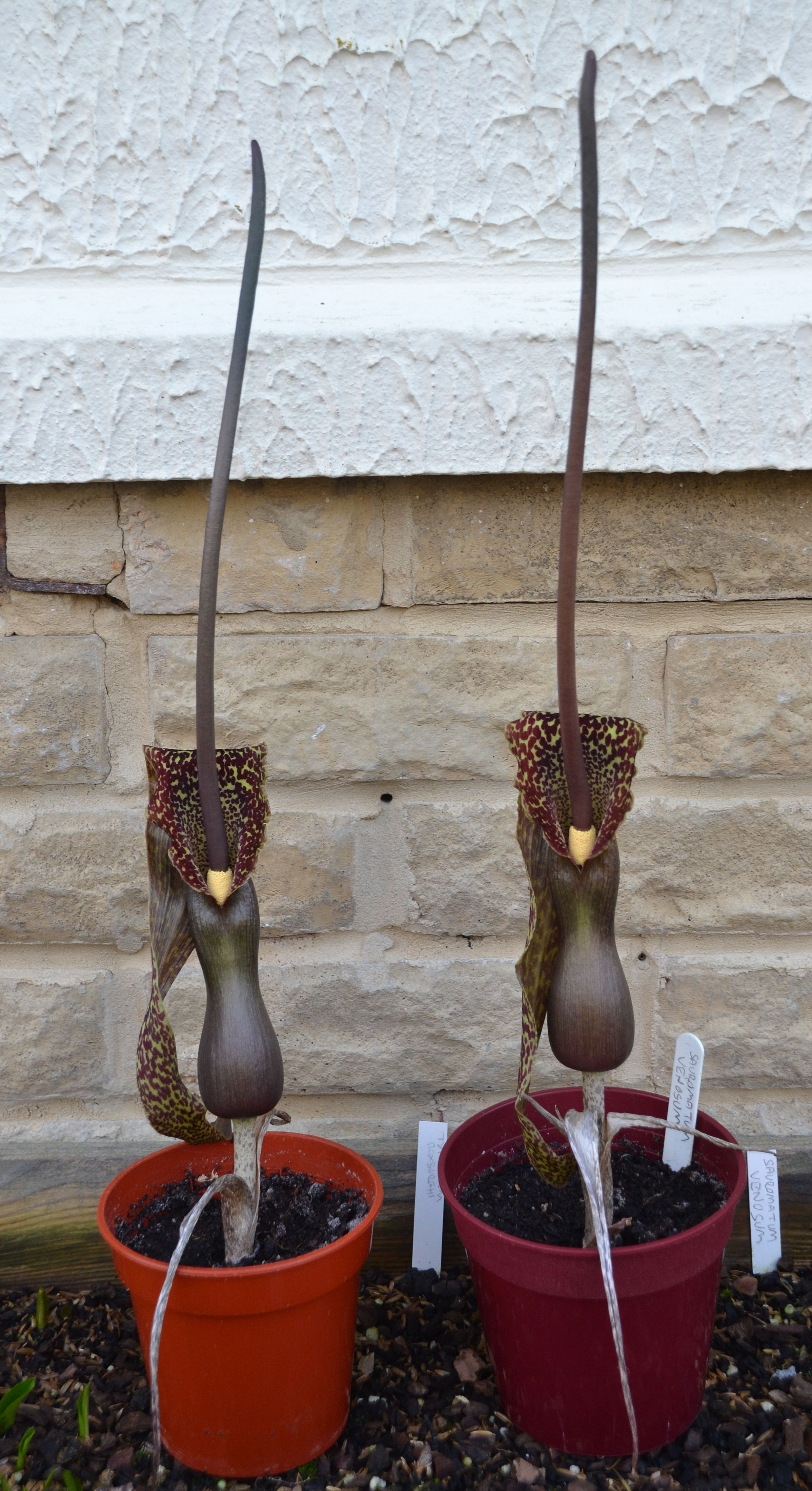
Typhonium roxburghii
Status: sourced (x2) from Himalayan Gardens in February 2020, these were grown indoors on a windowsill in 9cm plastic pots. The first plant (top row, below) flowered for just half a day on 25th May and the second on 8th July (bottom row) and are said to be repeat flowering throughout the summer. One of them bloomed again on 9th September 2021 (bottom row, right), then from June 2022 this plant repeat flowered for the first time. No blooms appeared in 2023. The rhizomes should be stored dry and frost free through the winter.





This is a compact Asian Aroid with diminutive triangular-shaped glossy green leaves. They will grow quickly in sheltered spots outdoors and slowly spread to create a small clump, but not being fully frost tolerant are often best grown indoors in pots. The deep red, velvety florescences are usually twisted at the end with a long thin spadix that extends beyond the spathe, giving the appearance of a miniature Dracunculus. Like the latter the one day blooms are malodorous, and this particular stinker packs quite a punch for its size. It is such a pity that they have to go outside.



